NMN
NMN (nicotinamide mononucleotide) has an indirect role in the survival of every one of our cells. To understand this role, we first need to take a few steps back.
Everything happening in any life form, like breathing, moving and even thinking is based on biochemical reactions. Every biochemical reaction requires energy. Our bodies take this energy from food and mitochondria convert it into the currency that every cell can use. A protagonist in energy production is a molecule called NAD (Nicotinamide Adenine Dinucleotide). NAD is found in two forms: NAD+ (oxidized form) and NADH (reduced form). NAD is a co-enzyme, a molecule that helps other proteins and enzymes do their job. One of these jobs is producing energy in mitochondria and reducing oxidative stress (1).
And yet, NAD does much more than that.
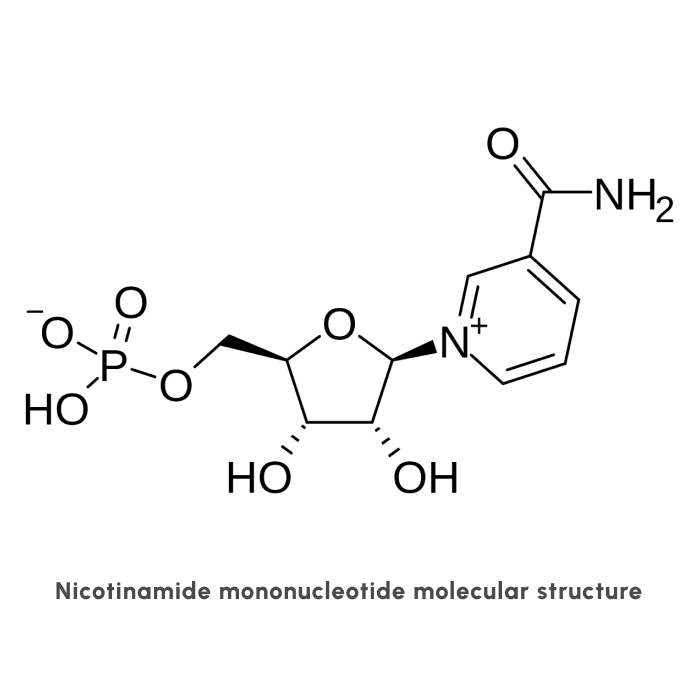
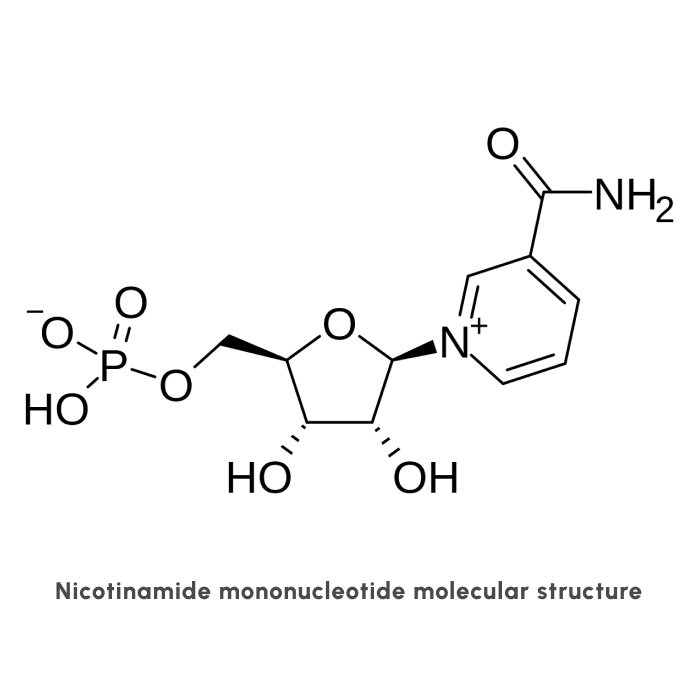
NAD: an essential molecule for life
NAD participates in more than 50% of all biochemical reactions in our bodies (2). One of these processes is DNA repair, or keeping the DNA intact. With time, DNA accumulates errors, or mutations, that if left uncorrected cause diseases like cancer. NAD collaborates with PARP, an enzyme responsible for correcting these errors and keeping the DNA healthy (3). Furthermore, NAD is a partner of CD38, a protein receptor expressed in plasma cells, and which plays a role in many processes like immune function, cancer and metabolic disease (4).
Another group of enzymes that NAD activates are the sirtuins (5). It would be fair to call sirtuins the “proteins of longevity”, as they are well-known for promoting healthy aging and longevity (6). Sirtuins are instrumental for the proper function of the cells including oxidative balance and DNA repair. As a result, their high activity is necessary for good cardiovascular, cognitive, metabolic and immune function.
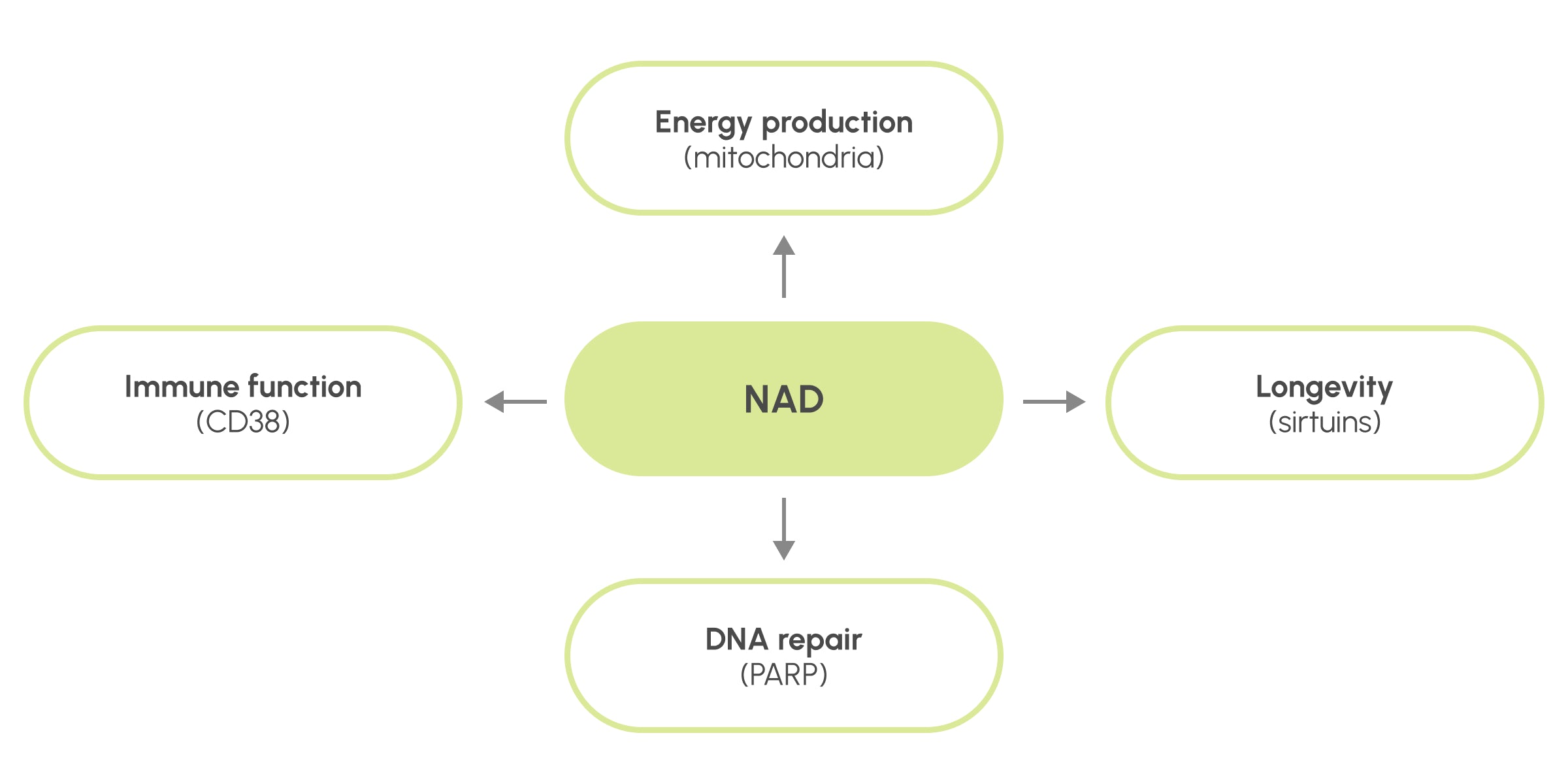
Figure 1: NAD is an important molecule for many functions at the cell and organism level. Among others, it participates in the energy production in the mitochondria, DNA repair (in collaboration with PARP), immune function (in collaboration with CD38) and overall health and longevity (in collaboration with the sirtuins).
NAD: nothing lasts forever
NAD is crucial for many core pathways in the cell. The enzymes we mentioned earlier compete for the available NAD. If somehow all NAD in our bodies ran out, we would not survive for more than a few seconds. The problem is that NAD levels drop with age (7). This is because the demand for it increases and its biosynthesis decreases. This reduction in NAD levels leads to a drop in mitochondrial function, sirtuins activity and DNA repair. This leads to an increase in oxidative stress and systemic malfunction, also known as ageing (8) . Consequently, low NAD activity is related to a higher risk of heart disease, Type 2 diabetes, Alzheimer’s disease and accelerated aging.
This is where NMN supplementation comes into play.
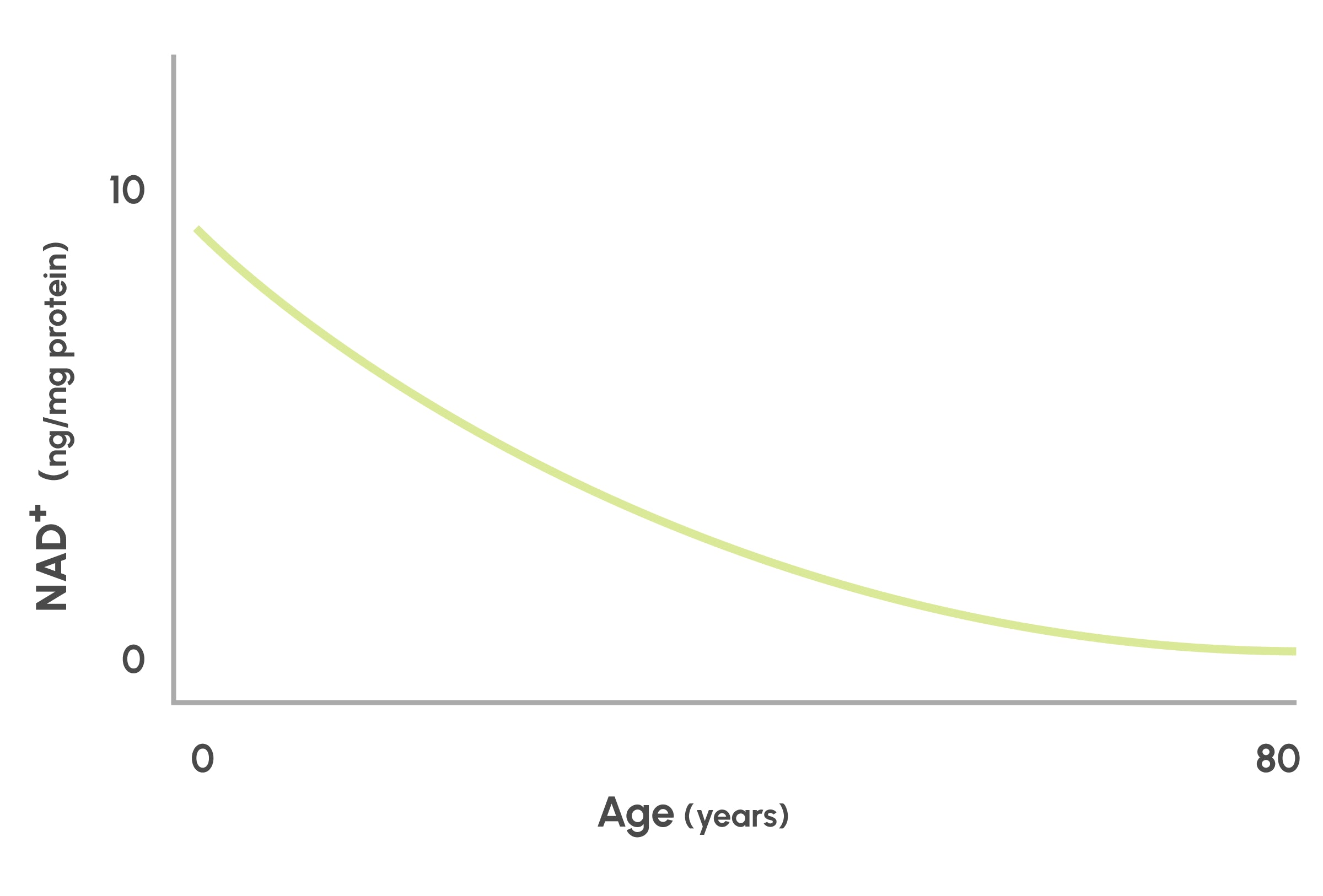
Figure 2: NAD levels decrease with age. NAD+levels (one of the two forms of NAD) as measured on human skin samples. The figure is based on the results by Massudi 2012 (7).
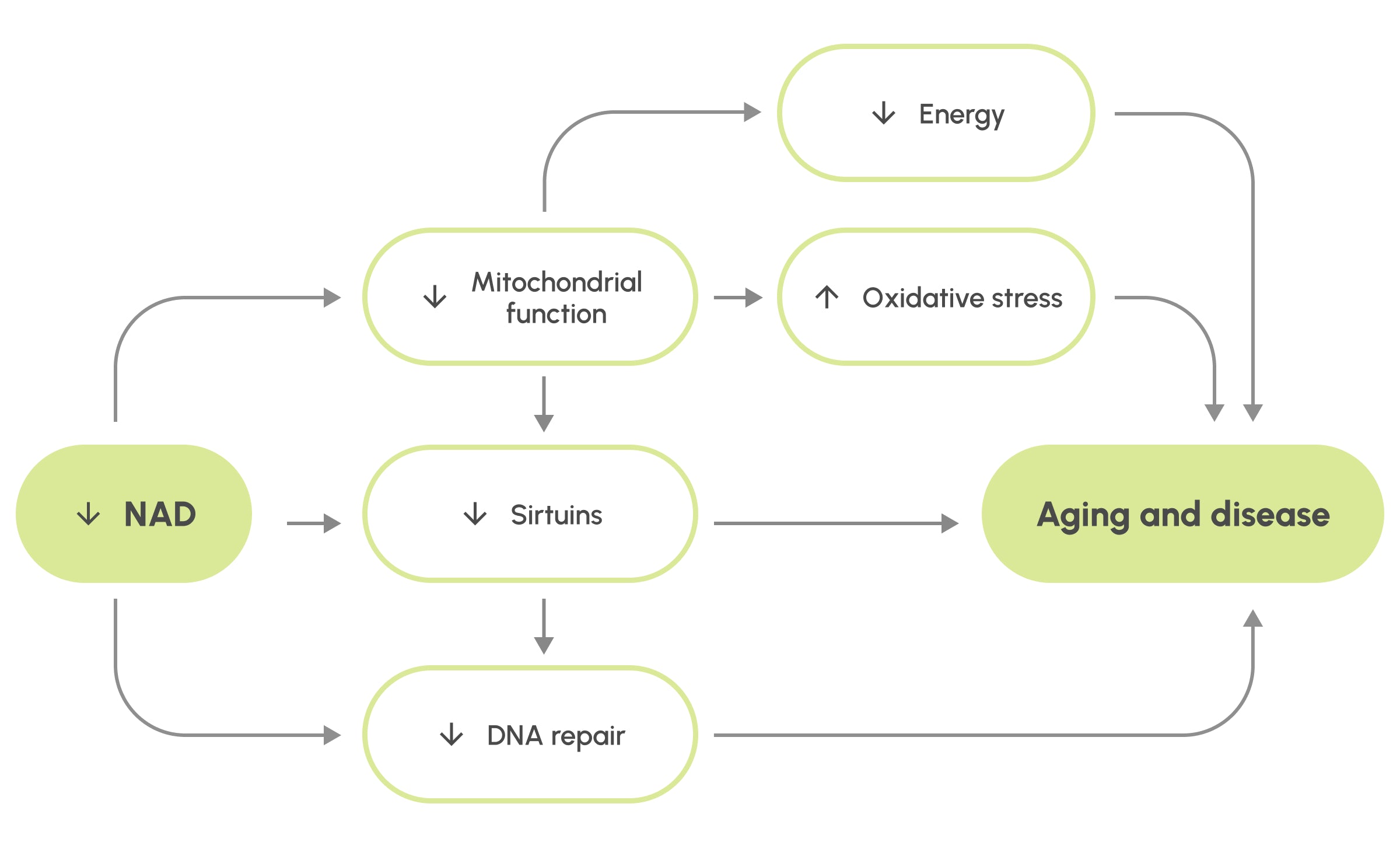
Figure 3: The drop of NAD leads to decrease in mitochondrial function, sirtuin activity and DNA repair, ultimately leading to aging and disease. Aging and disease further reduce the levels of NAD creating a vicious cycle.
NMN: a way to boost NAD
NMN (nicotinamide mononucleotide) is the immediate precursor of NAD. The cell uses NMN to make NAD. The reason we cannot take NAD directly is its big size that makes it hard to get into the cells. NMN is smaller and there is a specific transporter that brings it from the digestive system to blood circulation(9). When our body receives NMN, it transforms it to NAD. Therefore, NMN has driven a tremendous amount of research and holds a huge promise for health benefits.
When humans received NMN…
Clinical trials with NMN are relatively recent and mostly included older participants. Yet NMN so far is living up to the expectation. The first human studies showed that NMN supplementation is safe and directly increases NAD levels in the blood (10, 11). Furthermore, 600 or 1200 milligrams (mg) of NMN per day enhanced the aerobic capacity of amateur runners in only six weeks compared to runners that received a placebo (12). The authors believe that NMN increased the efficiency of the skeletal muscles in using oxygen. This is similar to mouse studies that show that NAD precursors increase strength and endurance (13, 14).
In another study, NMN showed promise against insulin sensitivity which may lead to type 2 diabetes and is a hallmark of aging. In that trial prediabetic, overweight and postmenopausal women received 250 mg of NMN daily. Ten weeks later, their skeletal muscle was more sensitive to insulin, at levels that compared to 10% weight loss or insulin sensitization treatment (15). This confirmed in vivo studies where NMN increased insulin secretion and sensitivity in diabetic mice (16).
The latest clinical trial explored diverse, systematic benefits for NMN. The participants, all older than 65 years old, received 250 mg NMN for 12 weeks. At the end of the study, NMN supplementation in the afternoon improved overall drowsiness and lower limb function (17). It is very important that NMN can be effective for many different health aspects even when taken later in life.
When animal received NMN…
Animal studies have paved the way for clinical trials and given us a glimpse of what NMN may be able to do in humans. There are numerous studies that show the exceptional effect of NMN in different aspects of aging (18). Multiple studies have shown that NMN rejuvenates the blood vessels, increases blood flow and overall protects the heart (19-21). In addition, it reduces oxidative stress and inflammation in the brain and even improved AD symptoms and reversed age-related brain dysfunction and improves memory (22-27). It also brought good news for fertility: it delayed reproductive aging and even reversed the decline in oocyte quality and fertility in aged mice (28, 29).
Lastly, in one of the main in vivo studies in the field, NMN promoted longevity by slowing down aging. It enhanced physical activity, metabolism, insulin sensitivity, body weight control and even eye function. Even gene expression maintained a “younger” profile for longer (13).
Conclusion
NMN supplementation based on current data is safe, it increases NAD levels and has a big potential in promoting longevity. Animal studies show exceptional results in improving different aspects of aging. These include physical performance, cardiovascular and cognitive function. Initial human trials are so far living up to the expectations of NMN and future studies will hopefully validate its potential for longevity and age-related diseases.
References
1. Klimova, N., Fearnow, A. & Kristian, T. Role of nad+—modulated mitochondrial free radical generation in mechanisms of acute brain injury. Brain Sciences vol. 10 1–13 Preprint at https://doi.org/10.3390/brainsci10070449 (2020).
2. Yoshino, J., Baur, J. A. & Imai, S. ichiro. NAD+ intermediates: The biology and therapeutic potential of NMN and NR. Cell Metab 27, 513 (2018).
3. Murata, M. M. et al. NAD+ consumption by PARP1 in response to DNA damage triggers metabolic shift critical for damaged cell survival. Mol Biol Cell 30, 2584 (2019).
4. Camacho-Pereira, J. et al. CD38 Dictates Age-Related NAD Decline and Mitochondrial Dysfunction through an SIRT3-Dependent Mechanism. Cell Metab 23, 1127–1139 (2016).
5. Imai, S. ichiro & Guarente, L. NAD+ and Sirtuins in Aging and Disease. Trends Cell Biol 24, 464 (2014).
6. Kane, A. E. & Sinclair, D. A. Sirtuins and NAD+ in the development and treatment of metabolic and cardiovascular diseases. Circ Res 123, 868–885 (2018).
7. Massudi, H. et al. Age-associated changes in oxidative stress and NAD+ metabolism in human tissue. PLoS One 7, (2012).
8. Shade, C. The Science Behind NMN-A Stable, Reliable NAD+ Activator and Anti-Aging Molecule. Integrative Medicine • vol. 19 (2020).
9. Grozio, A. et al. Slc12a8 is a nicotinamide mononucleotide transporter. Nature Metabolism 2019 1:1 1, 47–57 (2019).
10. Igarashi, M. et al. Chronic nicotinamide mononucleotide supplementation elevates blood nicotinamide adenine dinucleotide levels and alters muscle function in healthy older men. npj aging 8, (2022).
11. Okabe, K. et al. Oral Administration of Nicotinamide Mononucleotide Is Safe and Efficiently Increases Blood Nicotinamide Adenine Dinucleotide Levels in Healthy Subjects. Front Nutr 9, (2022).
12. Liao, B. et al. Nicotinamide mononucleotide supplementation enhances aerobic capacity in amateur runners: a randomized, double-blind study. J Int Soc Sports Nutr 18, (2021).
13. Mills, K. F. et al. Long-Term Administration of Nicotinamide Mononucleotide Mitigates Age-Associated Physiological Decline in Mice. Cell Metab 24, 795–806 (2016).
14. Crisol, B. M. et al. NAD + precursor increases aerobic performance in mice. Eur J Nutr 59, 2427–2437 (2020).
15. Yoshino, M. et al. Nicotinamide mononucleotide increases muscle insulin sensitivity in prediabetic women. Science (1979) 372, 1224–1229 (2021).
16. Yoshino, J., Mills, K. F., Yoon, M. J. & Imai, S. I. Nicotinamide Mononucleotide, a Key NAD+ Intermediate, Treats the Pathophysiology of Diet- and Age-Induced Diabetes in Mice. Cell Metab 14, 528–536 (2011).
17. Kim, M. et al. Effect of 12-Week Intake of Nicotinamide Mononucleotide on Sleep Quality, Fatigue, and Physical Performance in Older Japanese Adults: A Randomized, Double-Blind Placebo-Controlled Study. Nutrients 14, (2022).
18. Nadeeshani, H., Li, J., Ying, T., Zhang, B. & Lu, J. Nicotinamide mononucleotide (NMN) as an anti-aging health product – Promises and safety concerns. Journal of Advanced Research vol. 37 267–278 Preprint at https://doi.org/10.1016/j.jare.2021.08.003 (2022).
19. Das, A. et al. Impairment of an Endothelial NAD+-H2S Signaling Network Is a Reversible Cause of Vascular Aging. Cell 173, 74-89.e20 (2018).
20. de Picciotto, N. E. et al. Nicotinamide mononucleotide supplementation reverses vascular dysfunction and oxidative stress with aging in mice. Aging Cell 15, 522–530 (2016).
21. Hosseini, L., Vafaee, M. S. & Badalzadeh, R. Melatonin and Nicotinamide Mononucleotide Attenuate Myocardial Ischemia/Reperfusion Injury via Modulation of Mitochondrial Function and Hemodynamic Parameters in Aged Rats. J Cardiovasc Pharmacol Ther 25, 240–250 (2020).
22. Klimova, N., Long, A. & Kristian, T. Nicotinamide mononucleotide alters mitochondrial dynamics by SIRT3-dependent mechanism in male mice. J Neurosci Res 97, 975–990 (2019).
23. Long, A. N. et al. Effect of nicotinamide mononucleotide on brain mitochondrial respiratory deficits in an Alzheimer’s disease-relevant murine model. BMC Neurol 15, 1–14 (2015).
24. Johnson, S., Wozniak, D. F. & Imai, S. CA1 Nampt knockdown recapitulates hippocampal cognitive phenotypes in old mice which nicotinamide mononucleotide improves. npj Aging and Mechanisms of Disease 2018 4:1 4, 1–12 (2018).
25. Hosseini, L. et al. Nicotinamide Mononucleotide and Melatonin Alleviate Aging-induced Cognitive Impairment via Modulation of Mitochondrial Function and Apoptosis in the Prefrontal Cortex and Hippocampus. Neuroscience 423, 29–37 (2019).
26. Wang, X., Hu, X., Yang, Y., Takata, T. & Sakurai, T. Nicotinamide mononucleotide protects against β-amyloid oligomer-induced cognitive impairment and neuronal death. Brain Res 1643, 1–9 (2016).
27. Tarantini, S. et al. Nicotinamide mononucleotide (NMN) supplementation rescues cerebromicrovascular endothelial function and neurovascular coupling responses and improves cognitive function in aged mice. Redox Biol 24, 101192 (2019).
28. Bertoldo, M. J. et al. NAD+ Repletion Rescues Female Fertility during Reproductive Aging. Cell Rep 30, 1670-1681.e7 (2020).
29. Miao, Y., Cui, Z., Gao, Q., Rui, R. & Xiong, B. Nicotinamide Mononucleotide Supplementation Reverses the Declining Quality of Maternally Aged Oocytes. Cell Rep 32, 107987 (2020).
NMN Quality Reports
All of our product has been manufactured in a US-based, FDA, GMP, and NSF registered facility under strict GMP standards, and third-party lab tested.